Everything you need to know about the Dresden museum heist
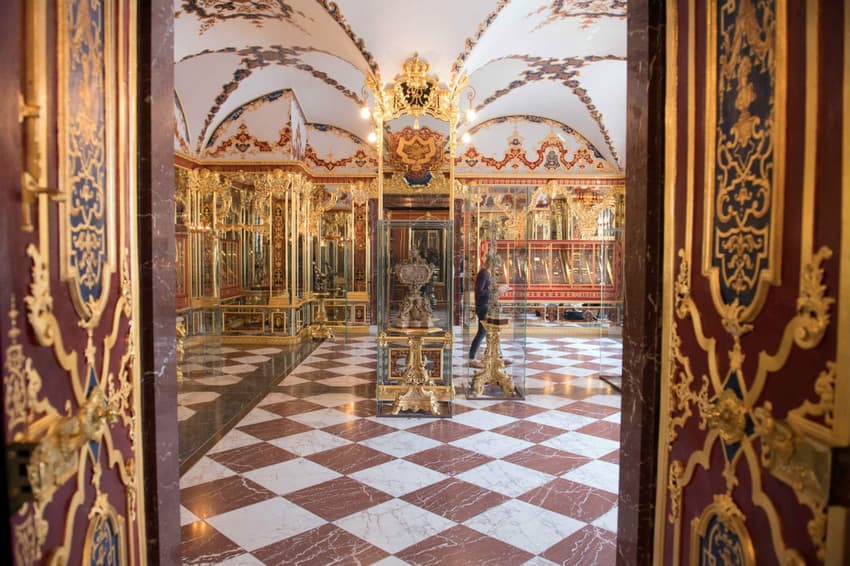
Monday's Green Vault break in was dubbed the largest art theft in Germany since World War II. Here's how it happened, what was stolen, and if there's hope of finding the objects.
Police in Germany were Tuesday hunting robbers who snatched priceless 18th century jewellery from a state museum in Dresden in what local media have called one the biggest art heists of all time.
Authorities across eastern Germany have been put on alert after thieves made off with treasures from the Green Vault at Dresden's Royal Palace in an astonishing smash-and-grab raid early Monday morning.
READ ALSO: Dresden museum burglary 'probably largest art theft since World War II'
Police have called for witnesses to step forward and released images of the stolen items, which were taken from a collection of jewellery of 18th-century Saxony ruler Augustus the Strong.
Here's what you need to know about the incident on Monday.
What happened?
The thieves launched their brazen raid after starting a fire at an electrical panel near the Residential Palace, where the Green Vault is situated, around 5am on Monday morning.
They deactivated its alarm as well as street lighting, said Dresden Chief of Police Volker Lange at a press conference.
Despite the power cut, a surveillance camera kept working and filmed two men breaking in.
A video released by police and now published on YouTube showed one of the men, armed with a torch, using an axe to smash the display case in the Green Vault.
"The whole act lasted only a few minutes," said police in a statement.
The suspects then fled in an Audi A6 and remain on the run.
The apparent getaway car was found on fire later elsewhere in the city, said police, adding that the vehicle was being examined for clues.
Bild daily said the heist was "probably the biggest art theft since World War Two".
What did the thieves steal?
One hundred objects from the jewellery sets of Friedrich August II are thought to be among the stolen items.
They include a sword whose hilt is encrusted with nine large and 770 smaller diamonds, and a diamond bow decorated with 662 brilliants.
The exact number of stolen objects is unclear. However, 11 of the known stolen objects have been published in a photo gallery.
It is "a state treasure of the 18th century," said Marion Ackermann, Director General of the State Art Collections.
Founded by Augustus the Strong, Elector of Saxony in 1723, the Green Vault is one of the oldest museums in Europe.
After the Royal Palace suffered severe damage in World War Two, the Green Vault remained closed for decades before it was restored and re-opened in 2006.
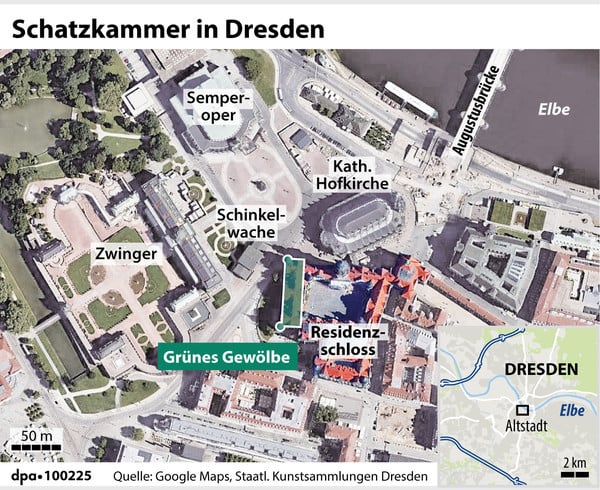
A DPA map shows the location of the Green Vault (Grünes Gewölbe) within the Residential Palace and Dresden's buildings in its Altstadt. Photo: DPA
What are the stolen objects worth?
Bild set the price tag on the stolen items as up to one billion euros. Yet according to General Director Ackermann, the value of the stolen property cannot be quantified.
The special significance lies less in the material, than in the comprehensiveness of the collection, she said.
READ ALSO: 'Up to a billion euros' of jewels and antiques stolen from Dresden museum
They hope that the stolen property has been removed from the art market because of its "international fame".
Have there been other art thefts of this magnitude?
Over the past century there have been several museum break-ins around the world. At one point, in 1911, Leonardo de Vinci's famed "Mona Lisa" was stolen from the Louvre Museum in Paris. This chart from Statista looks at other large museum break-ins. 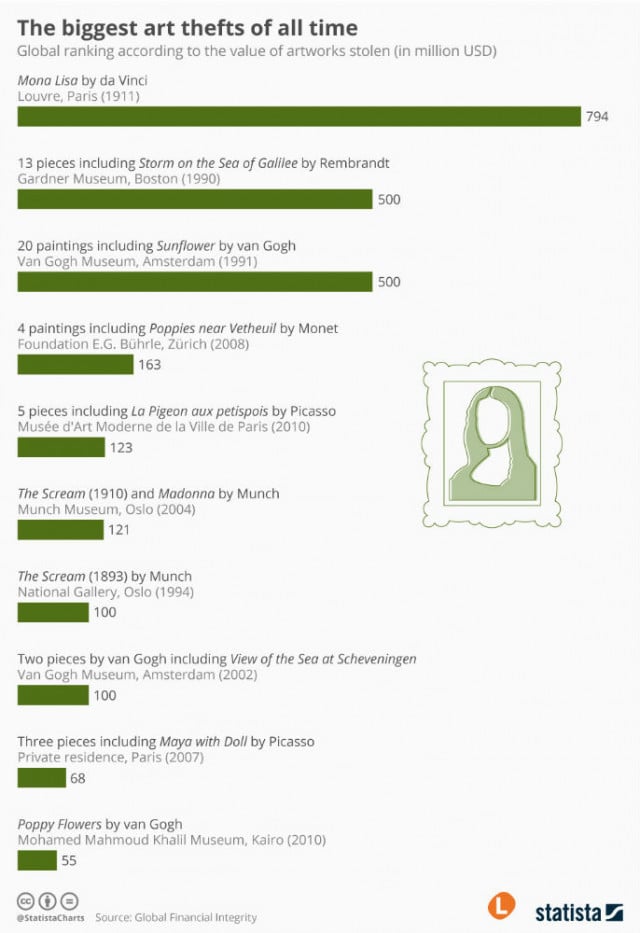
When will the Green Vault open again?
The Green Vault is no longer open to the public for the time being. Museum director Dirk Syndram told MDR that he expected the collection to remain closed for some time.
However, the other museums in the building will reopen on Wednesday, he added.
Are the stolen treasures insured?
Cultural objects from public museums are generally not insured, but damages are covered by so-called state liability. This is attractive for public museums as they do not have to pay insurance premiums.
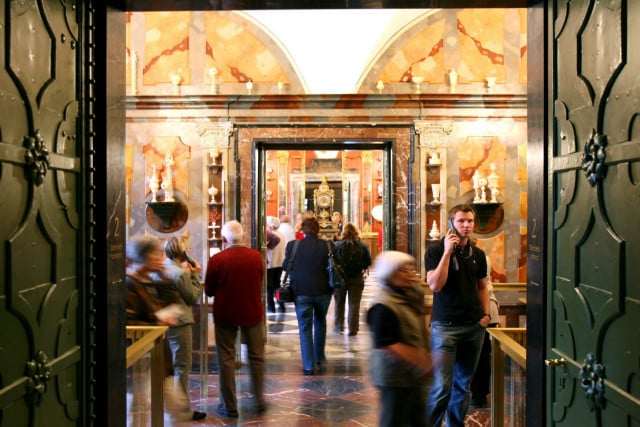
Archive photo shows visitors inside of the Green Vault. Photo: DPA
What is known about the perpetrators?
Investigators assume that there are several perpetrators. According to a police report, two burglars were visible over the cameras in the Green Vault. However, it was assumed that other parties were involved.
A ten person-strong special commission called "Epaulette" are responsible for searching for the suspects.
How is the collection in Dresden's Residential Palace secured?
Ackermann said the security centre in the building are always staffed by two guards. They had observed the burglars on their monitors in real time and then dialled the emergency number.
When the police arrived at the scene, however, the thieves had already fled.
What could the perpetrators be up to with the loot?
In an interview with Spiegel Online, the Dutch art detective Arthur Brand stressed that there are two key types of art thieves. On the one hand, there are perpetrators who are convinced that they will find one or more buyers for the stolen goods.
However, this is usually not the case, because the exhibits are too well-known and therefore quickly recognizable.
"As soon as the thieves realize that they cannot find a buyer, they look for alternatives. For example, they blackmail the insurance company," says Brand. "These art thieves are comparatively easy to convict."
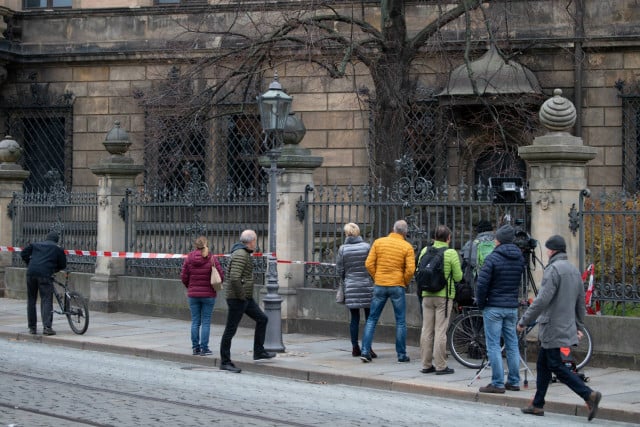
Passersby stand in front of the windows of the Green Vault on Tuesday morning. Photo: DPA
Much worse, he said, "are really professional thieves who re-melt the gold and silver or carve out the diamonds and sell them separately."
These perpetrators are aware that most works of art as a whole are not for sale, but can be turned into money when broken down into their components. But once melted down or dismantled, the art remains gone forever, he said.
How did politicians react to the theft?
Saxony's head of government, Michael Kretschmer (CDU), was appalled. "The values that can be found in the Green Vault and the Residence Palace have been hard earned by the people in the state of Saxony over many centuries," he said.
"It’s not possible to understand Saxony’s history without the Green Vault and the State Art Collections of Saxony".
Minister of Culture Monika Grütters described the break-in as shocking. The theft "of pieces that make up our identity as a cultural nation hits us in the heart," said the CDU politician.
She thanked those responsible for setting up a special commission and hoped that the search would be successful quickly.
"In light of the fact that the perpetrators of these crimes are getting better organized, we need to prioritize a stronger protection of our museums and cultural institutions," Grütters said.
"We have recently tightened up the security measures at our museums and cultural institutions in various places."
With reporting from AFP
Comments
See Also
Police in Germany were Tuesday hunting robbers who snatched priceless 18th century jewellery from a state museum in Dresden in what local media have called one the biggest art heists of all time.
Authorities across eastern Germany have been put on alert after thieves made off with treasures from the Green Vault at Dresden's Royal Palace in an astonishing smash-and-grab raid early Monday morning.
READ ALSO: Dresden museum burglary 'probably largest art theft since World War II'
Police have called for witnesses to step forward and released images of the stolen items, which were taken from a collection of jewellery of 18th-century Saxony ruler Augustus the Strong.
Here's what you need to know about the incident on Monday.
What happened?
The thieves launched their brazen raid after starting a fire at an electrical panel near the Residential Palace, where the Green Vault is situated, around 5am on Monday morning.
They deactivated its alarm as well as street lighting, said Dresden Chief of Police Volker Lange at a press conference.
Despite the power cut, a surveillance camera kept working and filmed two men breaking in.
A video released by police and now published on YouTube showed one of the men, armed with a torch, using an axe to smash the display case in the Green Vault.
"The whole act lasted only a few minutes," said police in a statement.
The suspects then fled in an Audi A6 and remain on the run.
The apparent getaway car was found on fire later elsewhere in the city, said police, adding that the vehicle was being examined for clues.
Bild daily said the heist was "probably the biggest art theft since World War Two".
What did the thieves steal?
One hundred objects from the jewellery sets of Friedrich August II are thought to be among the stolen items.
They include a sword whose hilt is encrusted with nine large and 770 smaller diamonds, and a diamond bow decorated with 662 brilliants.
The exact number of stolen objects is unclear. However, 11 of the known stolen objects have been published in a photo gallery.
It is "a state treasure of the 18th century," said Marion Ackermann, Director General of the State Art Collections.
Founded by Augustus the Strong, Elector of Saxony in 1723, the Green Vault is one of the oldest museums in Europe.
After the Royal Palace suffered severe damage in World War Two, the Green Vault remained closed for decades before it was restored and re-opened in 2006.

A DPA map shows the location of the Green Vault (Grünes Gewölbe) within the Residential Palace and Dresden's buildings in its Altstadt. Photo: DPA
What are the stolen objects worth?
Bild set the price tag on the stolen items as up to one billion euros. Yet according to General Director Ackermann, the value of the stolen property cannot be quantified.
The special significance lies less in the material, than in the comprehensiveness of the collection, she said.
READ ALSO: 'Up to a billion euros' of jewels and antiques stolen from Dresden museum
They hope that the stolen property has been removed from the art market because of its "international fame".
Have there been other art thefts of this magnitude?
Over the past century there have been several museum break-ins around the world. At one point, in 1911, Leonardo de Vinci's famed "Mona Lisa" was stolen from the Louvre Museum in Paris. This chart from Statista looks at other large museum break-ins. 
When will the Green Vault open again?
The Green Vault is no longer open to the public for the time being. Museum director Dirk Syndram told MDR that he expected the collection to remain closed for some time.
However, the other museums in the building will reopen on Wednesday, he added.
Are the stolen treasures insured?
Cultural objects from public museums are generally not insured, but damages are covered by so-called state liability. This is attractive for public museums as they do not have to pay insurance premiums.

Archive photo shows visitors inside of the Green Vault. Photo: DPA
What is known about the perpetrators?
Investigators assume that there are several perpetrators. According to a police report, two burglars were visible over the cameras in the Green Vault. However, it was assumed that other parties were involved.
A ten person-strong special commission called "Epaulette" are responsible for searching for the suspects.
How is the collection in Dresden's Residential Palace secured?
Ackermann said the security centre in the building are always staffed by two guards. They had observed the burglars on their monitors in real time and then dialled the emergency number.
When the police arrived at the scene, however, the thieves had already fled.
What could the perpetrators be up to with the loot?
In an interview with Spiegel Online, the Dutch art detective Arthur Brand stressed that there are two key types of art thieves. On the one hand, there are perpetrators who are convinced that they will find one or more buyers for the stolen goods.
However, this is usually not the case, because the exhibits are too well-known and therefore quickly recognizable.
"As soon as the thieves realize that they cannot find a buyer, they look for alternatives. For example, they blackmail the insurance company," says Brand. "These art thieves are comparatively easy to convict."

Passersby stand in front of the windows of the Green Vault on Tuesday morning. Photo: DPA
Much worse, he said, "are really professional thieves who re-melt the gold and silver or carve out the diamonds and sell them separately."
These perpetrators are aware that most works of art as a whole are not for sale, but can be turned into money when broken down into their components. But once melted down or dismantled, the art remains gone forever, he said.
How did politicians react to the theft?
Saxony's head of government, Michael Kretschmer (CDU), was appalled. "The values that can be found in the Green Vault and the Residence Palace have been hard earned by the people in the state of Saxony over many centuries," he said.
"It’s not possible to understand Saxony’s history without the Green Vault and the State Art Collections of Saxony".
Minister of Culture Monika Grütters described the break-in as shocking. The theft "of pieces that make up our identity as a cultural nation hits us in the heart," said the CDU politician.
She thanked those responsible for setting up a special commission and hoped that the search would be successful quickly.
"In light of the fact that the perpetrators of these crimes are getting better organized, we need to prioritize a stronger protection of our museums and cultural institutions," Grütters said.
"We have recently tightened up the security measures at our museums and cultural institutions in various places."
With reporting from AFP
Join the conversation in our comments section below. Share your own views and experience and if you have a question or suggestion for our journalists then email us at [email protected].
Please keep comments civil, constructive and on topic – and make sure to read our terms of use before getting involved.
Please log in here to leave a comment.